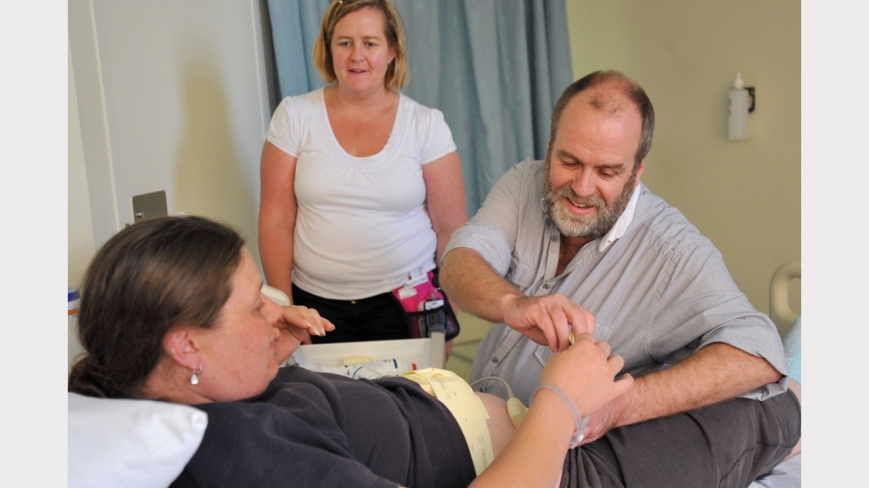Women are reclaiming their birth rights as the role of the midwife is reborn.
Arriving in Australia as a midwife in 1985, Christine Kerr experienced a huge culture shock. In her native UK she enjoyed the status of a highly respected profession, yet here she struggled to explain what it was she did for a living.
“People simply did not know what a midwife was, whereas in England, the most important person when a woman is pregnant is the midwife,” the Western Health women’s clinic nurse unit manager recalls.
“At that time in Australia the field was very much obstetric-led and midwives were handmaidens. For me it was a bit of a challenge because I came from a totally autonomous practice in England where we did the whole gamut, which included giving drugs out and examinations.”
Fast forward 27 years and Kerr can happily declare “finally we have reclaimed our ground”.
The culture of pregnancy and birth has undergone a quantum shift with the rise of the professional accoucheuse (female obstetrician or midwife) and the opportunity to train specifically as midwives rather than as an adjunct to nursing.
Sunshine Hospital now boasts Victoria’s largest midwifery group practice with more than 120 midwives on the roster providing about 60 per cent of all maternity care from antenatal clinics to birth and post natal.
Since the introduction of the midwife group practice the number of births at Sunshine has risen from from 3513 in 2008-09 to 4588 in 2011-12.
At the same time, the number of women giving birth vaginally without requiring episiotomies, receiving epidurals or experiencing post partum haemorrhaging has also risen significantly. It reflects more informed choices being made by women.
Julia Pring moved from Mercy Hospital to Western Health specifically to be part of the caseload model of one-on-one maternity care Sunshine Hospital offers.
This smaller group of midwives also works with women assessed at low risk of complication wanting to give birth at home. Since Sunshine’s pilot began in 2010 there have been 141 home births.
“Every month there are more and more women wanting to birth at home,” Pring says. “It’s funny that it’s seen as abnormal. Birthing at home feels like the most natural place for a woman to have her baby. She can have her other children around, hop into her own bed and go on with her normal life.”
This emphasis on childbirth as a normal physiological process is the midwives’ mantra.
“Midwives are experts of normal birth and obstetricians are experts of complications in pregnancy, so assuming everything is normal throughout pregnancy then midwives are the people to provide that care,” Pring adds.
“It is really important that people know that pregnancy is not something to be cured. It is not an illness,” says midwife educator Kate Russell. “But we are not here to tell people what to do. If you want to have an elective caesar, formula-feed your baby and put it into creche at three days old, I don’t judge you.
“It’s about informed consent. People put more research into their mobile phones or home insurance than they do into having a baby sometimes; you’d be amazed.”
Of course, not every pregnancy has a happy ending and midwives are there for families on those occasions also. Midwife Brindie McPhee, had not long graduated when she volunteered to assist a family with a stillbirth.
“It’s very, very sad and very hard to separate yourself from the family, but we have good support and there is always a debriefing.”
As Russell puts it: “We are so blessed in what we do. We get the highest of the highs, but also the lowest of the lows. Thankfully the lows are infrequent these days.”
Some people would be surprised to discover there are three male midwives on staff at Sunshine. “It has stopped a lot of conversations,” Ian Kenny laughs.
However, while there are some obvious cultural sensitivities, women who baulk at having a male midwife might also want to consider the sex of their obstetrician — the majority being male.
“I have birthed Muslim ladies,” Kenny reveals. “There are occasions where women don’t want a male midwife, but I find most women are more interested in having someone who knows what they are talking about and is empathetic toward what they are experiencing.’’
Kenny switched to midwifery after nearly two decades working in critical care.
“I’m very glad I did it, but for reasons I didn’t expect,” he says. “When I made the decision to do ‘mid’ everyone said it’s going to be so nice for you. You are going to get to hold babies and it is going to be beautiful to see new life instead of people dying.
“And that’s all true and good, but what really got me is that in critical care you tend to do things to people. There is not a lot of discussion, not a lot of negotiation, whereas midwifery is very much a partnership between me and the woman and her family.’’
The term midwife — which derives from old English and means literally ‘with woman’ — doesn’t bother him in the slightest. “As a male midwife I am still ‘with woman’. My long-running joke is that if I was midhusband, I’d be taking dad down the pub for a beer.”
BIRTHS AT SUNSHINE HOSPITAL
2003-04 ……….2681
2004-05 ………. 2930
2005-06 ………. 3097
2006-07 ………. 3317
2007-08 ………. 3392
2008-09 ………. 3513
2009-10 ………. 3977
2010-11 ………. 4338
2011-12 ………. 4588








